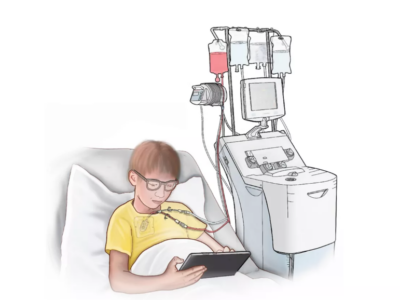What is Leaukapheresis?
Leukapheresis is a specialized medical procedure used to separate and remove white blood cells (leukocytes) from a patient’s blood. This technique plays a crucial role in both diagnostic and therapeutic settings, particularly in the treatment of certain cancers, autoimmune diseases, and other medical conditions where the control of white blood cell levels is vital.
Leukapheresis is a type of apheresis, a broader term that refers to the process of separating different components of blood; such as plasma, platelets, red blood cells, and white blood cells using a machine called an apheresis device. In leukapheresis, the focus is specifically on the removal of white blood cells. These cells play a pivotal role in the immune system by fighting infections, but in certain conditions, their excessive or abnormal proliferation can be harmful.

Mobil Dialysis provides Leukapheresis treatment to pediatric patients for two main purposes: therapeutic and diagnostic.
- Therapeutic Leukapheresis:
- Leukemia and Other Blood Cancers: In cases of acute leukemia, patients often experience a rapid increase in white blood cells. This can lead to a condition called leukostasis, where the high number of leukocytes can cause blood to thicken, leading to complications such as stroke, respiratory distress, and organ failure. Leukapheresis is used to quickly reduce the white blood cell count, alleviating these symptoms and preventing further complications.
- Autoimmune Diseases: In autoimmune conditions like rheumatoid arthritis or systemic lupus erythematosus, the immune system mistakenly attacks the body’s tissues. By removing specific subsets of white blood cells, leukapheresis can help reduce the immune system’s overactivity, providing relief from symptoms.
- Stem Cell Transplantation: Before a stem cell transplant, leukapheresis may be used to collect stem cells from the blood. These stem cells can be stored and later reinfused into the patient after they have undergone chemotherapy or radiation therapy.
- Diagnostic Leukapheresis:
- Research and Clinical Trials: Leukapheresis is often used in research settings to collect white blood cells for study. These cells can be analyzed to understand various diseases better, develop new treatments, or assess the effectiveness of existing therapies.
- Biomarker Discovery: In some cases, leukapheresis is performed to collect white blood cells that can be tested for specific biomarkers, which are indicators of disease or the body’s response to treatment.
The Leukapheresis Procedure
The leukapheresis procedure is generally safe and well-tolerated, though it can be lengthy, often lasting between two to four hours. Here’s what patients can typically expect during the process:
- Preparation:
- Initial Assessment: Before undergoing leukapheresis, patients undergo a thorough medical evaluation. This includes blood tests to determine the number and type of white blood cells, as well as other factors like platelet count and hematocrit levels.
- Venous Access: The procedure requires access to the patient’s blood. This is usually achieved through a peripheral vein, typically in the arms. However, in cases where large volumes of blood need to be processed or if the patient’s veins are not suitable, a central venous catheter may be used.
- The Apheresis Process:
- Blood Collection: Blood is drawn from the patient and passed through an apheresis machine. This machine separates the blood into its different components using a centrifuge.
- White Blood Cell Separation: The machine isolates the white blood cells from the other components. Depending on the goal of the procedure, specific types of white blood cells may be targeted for removal.
- Return of Blood Components: The remaining components of the blood, such as red blood cells, plasma, and platelets, are returned to the patient’s circulation.
- Post-Procedure Care:
- Monitoring: After leukapheresis, patients are monitored for any immediate side effects, such as dizziness, fatigue, or changes in blood pressure. These effects are usually mild and temporary.
- Follow-Up: Depending on the underlying condition being treated, patients may require multiple leukapheresis sessions over a period of time. Regular follow-up appointments are essential to monitor the patient’s response to the procedure and adjust treatment as necessary.
Benefits of Leukapheresis
Leukapheresis offers several benefits, particularly for patients with conditions that involve abnormal white blood cell counts:
- Rapid Reduction of Leukocytes: In emergencies, leukapheresis can quickly lower dangerously high white blood cell levels, preventing complications and stabilizing the patient’s condition.
- Targeted Treatment: Unlike systemic therapies, which affect the entire body, leukapheresis allows for the targeted removal of specific cell types, potentially reducing side effects and improving outcomes.
- Collection of Cells for Research and Therapy: The procedure is invaluable in research and the development of personalized treatments, particularly in the fields of oncology and immunology.
Risks and Considerations
While leukapheresis is generally considered safe, it is not without risks. Some potential complications include:
- Low Blood Pressure: The removal of blood and its components can cause a temporary drop in blood pressure, leading to dizziness or fainting.
- Calcium Depletion: The anticoagulants used during the procedure to prevent blood clotting can bind to calcium, leading to low calcium levels in the blood. This can cause symptoms such as tingling, muscle cramps, or, in rare cases, cardiac arrhythmias.
- Infection and Bleeding: As with any procedure involving venous access, there is a risk of infection or bleeding at the insertion site.
- Allergic Reactions: Some patients may have allergic reactions to the anticoagulants or other medications used during the procedure.
Leukapheresis is a vital medical procedure with diverse applications in both the treatment and diagnosis of various conditions. By selectively removing white blood cells from the blood, it offers a targeted approach to managing diseases where these cells play a central role. While the procedure is generally safe, it is important for patients to be aware of the potential risks and to work closely with their healthcare providers to ensure the best possible outcomes. As research and technology continue to evolve, leukapheresis is likely to remain a cornerstone of therapeutic and diagnostic strategies in modern medicine.
